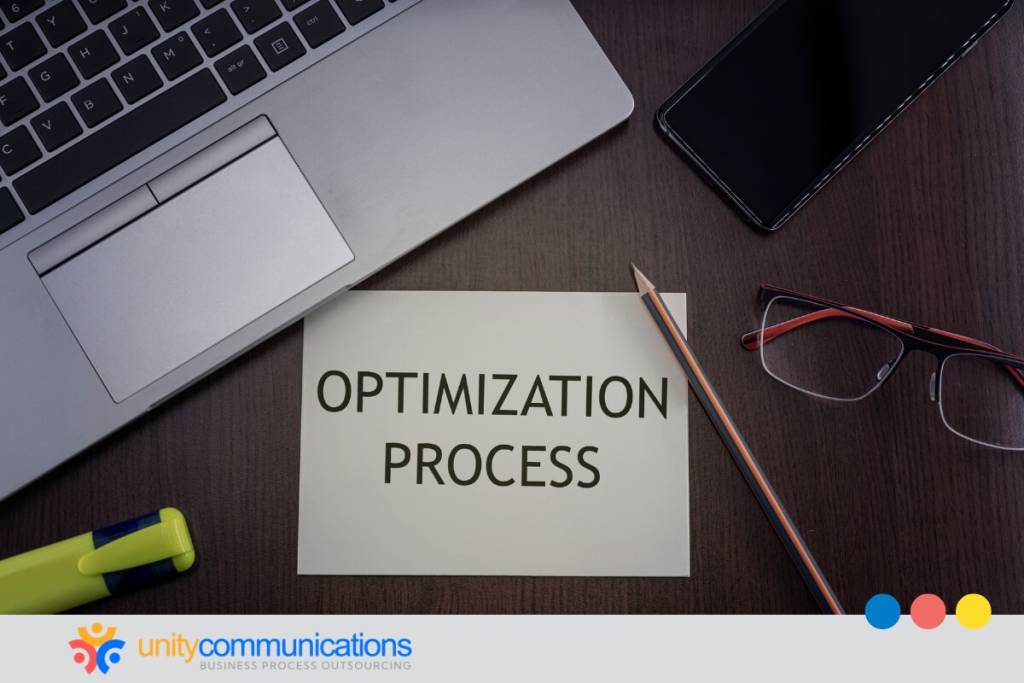Table of Contents
Achieving peak efficiency is critical for service providers to thrive in the competitive business process outsourcing (BPO) landscape. By meticulously examining and refining workflows, vendors can boost their delivery speed up to 20% and save between 20% and 30% on fixed costs.
This article delves into proven strategies, methodologies, and real-world examples to guide BPO managers, process engineers, and continuous improvement specialists in unlocking the full potential of their operations. BPO process optimization studies and techniques offer insights instrumental in driving these improvements.
Let’s explore how to transform your BPO operations through in-depth process optimization.
Process Optimization Fundamentals in BPO

What is BPO process optimization, and why is it crucial for service providers? It is the practice of streamlining workflows and eliminating bottlenecks in BPO operations. It enhances service quality and maintains the competitiveness of BPO companies.
BPO process optimization involves analyzing and redesigning core processes for optimal performance and maximized resource use. Outsourcing vendors can improve efficiency, effectiveness, and adaptability, laying the groundwork for automation.
Process optimization is vital to business process management (BPM), a discipline and technology that tracks, evaluates, and refines processes to achieve optimal business outcomes.
Benefits of effective business process optimization
Process optimization is a rewarding endeavor that enhances adaptability, efficiency, and effectiveness within BPO operations. Here are its essential benefits:
- Efficiency. Optimization simplifies processes by removing unnecessary barriers and automating tasks, allowing employees to focus on what matters.
- Cost savings. Improved efficiency and productivity ultimately boost your bottom line.
- Competitive advantage. Continuous optimization gives you a significant edge over competitors in efficiency, effectiveness, quality management, and more.
- Resource allocation. Optimized production processes reduce waste and inefficiencies, maximizing your investment.
- Continuous improvement. Process optimization fosters an environment of ongoing enhancement, ensuring your organization operates at its best with available resources.
- Innovation. Automating mundane tasks frees employees to focus on creative and strategic work.
- Adaptability. Process optimization’s flexibility helps businesses adjust to new regulations, customer needs, and market conditions.
- Customer satisfaction. Increased efficiency leads to faster response times, personalized services, quality improvements, and accurate delivery, all of which boost customer satisfaction.
- Employee satisfaction. Automating outdated, manual processes makes employees happier and more productive.
Key business process optimization techniques

An effective optimization strategy requires strategic planning and practical implementation. The following are essential techniques to consider for successful BPO process optimization:
PDSA
The plan-do-study-act (PDSA) approach focuses on iterative improvement through planning, testing, analyzing, and refining changes.
- Plan. Set specific, measurable goals and create a detailed implementation plan.
- Do. Test the changes on a small scale to identify potential issues.
- Study. Analyze the pilot results to determine if the changes met the objectives and identify any problems.
- Act. Implement successful changes on a larger scale. Standardize the improvements and make adjustments as needed.
DMAIC
Define-Measure-Analyze-Improve-Control (DMAIC) is a data-driven method used to improve existing processes.
- Define. Identify the process needing enhancement, set goals, and define the project scope.
- Measure. Collect data to establish baseline performance and pinpoint areas for improvement.
- Analyze. Use data analysis to find the root causes of inefficiencies.
- Improve. Develop and test solutions to address the root causes and then refine them.
- Control. Implement management systems to sustain improvements.
Kaizen
Kaizen emphasizes continuous, incremental business improvements.
- Continuous improvement. Focus on making minor, ongoing enhancements to processes.
- Employee involvement. Encourage all employees to suggest and implement enhancements, fostering a culture of innovation.
- Error reduction. Aim to decrease errors and defects through systematic, minor changes.
- Value addition. Enhance quality, reduce waste, and increase productivity to improve customer satisfaction.
Optimizing business processes with advanced technology

Optimizing business processes often relies on advanced technology to orchestrate and automate workflows. Here are some solutions to consider:
- Automation tools. Robotic process automation (RPA) handles repetitive tasks, allowing human resources (HR) to focus on higher-value activities.
- Cloud-based platforms. This BPO tech enhances collaboration, offers real-time visibility, and supports scalability across distributed teams.
- Artificial intelligence (AI) and machine learning (ML). AI and ML analyze large datasets to detect patterns and predict outcomes. They improve efficiency in tasks such as email and document classification and accelerate the creation of new workflows combined with low-code development.
- Process automation. Integrate AI, RPA, and unified workflows to streamline repetitive tasks, ensure compliance, and facilitate smooth handoffs between employees and digital workers.
- Data fabric. This technology consolidates data from various systems, helping identify inefficiencies and optimize processes.
- Process mining. This tool visualizes and measures processes and their variants and provides insights that are difficult to obtain manually.
Successful BPO process optimization: Case studies
The transformative power of BPO process optimization is undeniable, and case studies demonstrate its tangible benefits and inspire innovation within the industry.
Read on and learn insights from these success stories:
Accelerating customer onboarding at GlobalTech Solutions
GlobalTech Solutions, a leading telecom BPO firm, grappled with rising customer churn due to lengthy onboarding processes. To address this, they implemented a comprehensive process optimization initiative.
By automating routine tasks, standardizing procedures, and mapping the customer journey, GlobalTech significantly improved efficiency. The results were impressive: a 30% reduction in onboarding time, a 15% increase in customer satisfaction, and a 10% decrease in churn.
Using BPO tools to fast-track credit issuance
IBM, one of the top vendors of BPO tools worldwide, observed a grave inefficiency in its credit operations. From application to approval, credit issuance should’ve taken only 90 minutes. However, IBM researchers found that the actual processing took one week on average.
To improve processing time, IBM assigned “deal structurers” to oversee processing and developed a new tool to automate specific tasks within the workflow. This approach enhanced collaboration and agility in processing, showcasing IBM’s thought leadership.
The bottom line

Business process optimization is a continuous journey that requires a strategic approach, technological adoption, and commitment to excellence. By embracing these principles and leveraging insights from BPO process optimization studies, companies can maximize their full potential, deliver exceptional value to clients, and gain a competitive edge in the market.
Let’s connect to explore how we can help your organization embark on a successful process optimization journey.




